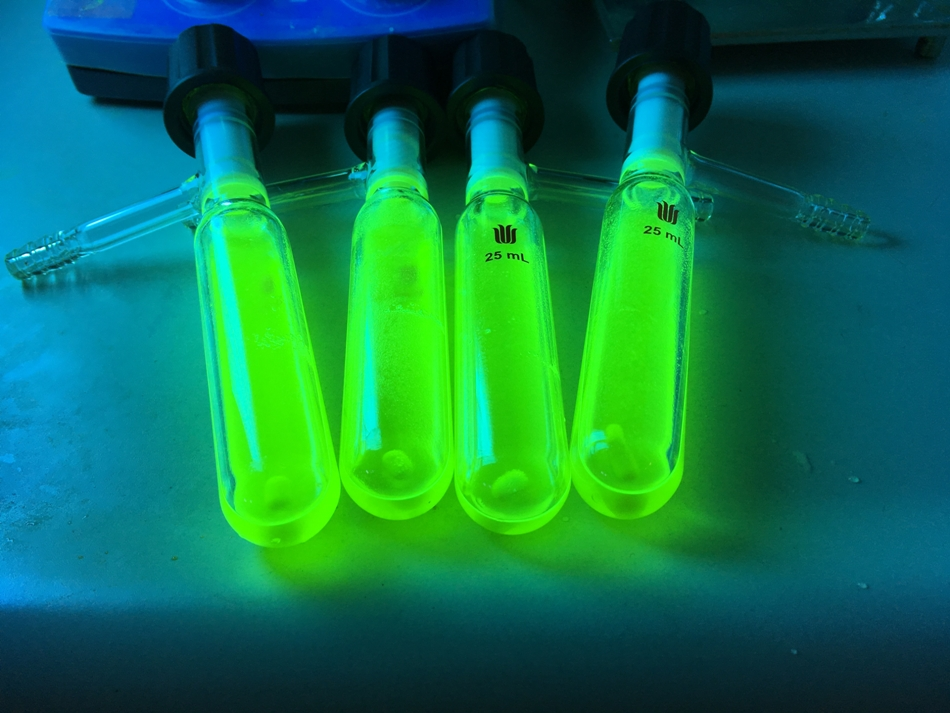May 4 2020
Researchers from the Paul Scherrer Institute (PSI) have analyzed a potential material for organic light-emitting diodes (OLEDs).
 CuPCP gives off an intense green glow not only when current is applied, but also under UV light. Image Credit: University of Bremen/Matthias Vogt.
CuPCP gives off an intense green glow not only when current is applied, but also under UV light. Image Credit: University of Bremen/Matthias Vogt.
Thanks to its high light yields and cost-effective production on a large scale, it can be synthesized for use in large-area room lighting. For a long time, scientists were seeking such materials.
In the coming years, the newly gained insight will enable the economic and quick development of new lighting appliances. The study was recently reported in the Nature Communications journal.
When the yellowish solid compound is dissolved in a liquid or a thin layer of it is deposited on an electrode and electric current is applied, it emits an intense green glow.
The cause for the glow is that the molecules consume the energy supplied to them and slowly emit it again in the form of light. This process is known as electroluminescence. This is the underlying principle for LEDs.
This green luminescent substance is a promising material for creating OLEDs. For nearly three years, OLEDs have been used in the displays of smartphones, for instance. Meanwhile, the first flexible television screens made with such materials are available commercially in the market.
Moreover, with OLEDs, it is possible to achieve economical room lighting with a huge surface area. But first, it is necessary to find the materials that are appropriate for this application. The reason is several substances proposed for producing OLEDs consist of costly materials like iridium, and this hampers their use on a large scale and wider surfaces.
The materials can only emit a small part of the energy supplied to them as light without the use of these additives, and the remaining energy is lost, for instance, as vibrational energy.
At present, studies aim to discover more efficient materials for low-cost, more eco-friendly displays and large-area lighting. In this context, growth has been assured by the cheap and readily available metals like copper.
Under Close Examination
Currently, scientists have made a highly accurate study of the copper-containing compound CuPCP. Four copper atoms are present in the middle of each molecule, encircled by phosphorus and carbon atoms. Copper is a comparatively affordable metal, and large quantities of the compound can be produced easily—perfect preconditions for use over very wide surfaces.
We wanted to understand what the excited state of the compound looks like.
Grigory Smolentsev, Physicist, Operando Spectroscopy Research Group, Paul Scherrer Institute
In simple terms: How does the substance get modified upon absorbing energy? For example, does the structure of the molecule vary? How the charge gets distributed over the separate atoms following excitation?
This reveals how high the losses of energy that will not be released as light are likely to be and it shows us how we can possibly minimize these losses.
Grigory Smolentsev, Physicist, Operando Spectroscopy Research Group, Paul Scherrer Institute
Smolentsev and his colleagues used the two huge research facilities at PSI—the X-ray free-electron laser SwissFEL and the Swiss Light Source SLS—as well as the European Synchrotron Radiation Facility in Grenoble, France, and closely observed the temporary excited states of the copper compound.
From the measurements, it was verified that the substance is a promising material for OLEDs, thanks to its chemical structure. It is possible to realize a high light yield due to the quantum chemical properties of the compound.
One reason for this is that the molecule is comparatively hard, and its 3D structure varies only slightly upon excitation. Scientists can now optimize this substance further for use in OLEDs.
Tools for the Future
Furthermore, the measurements at the three large research facilities—at PSI and in Grenoble—were crucial not just for the analysis of this single copper-containing compound. The experimental data thus achieved is also useful to enhance theoretical calculations with respect to molecules in general.
So in the future it will be possible to better predict which compounds are more suitable for OLEDs and which less. The measurement data will help the chemists understand which part of the molecule stands in the way of high efficiency. And of course: how the compound can be improved to increase its light output.
Grigory Smolentsev, Physicist, Operando Spectroscopy Research Group, Paul Scherrer Institute
The study outcomes were recently described in the Nature Communications journal.
Journal Reference:
Smolentsev, G., et al. (2020) Taking a snapshot of the triplet excited state of an OLED organometallic luminophore using X-rays. Nature Communications. doi.org/10.1038/s41467-020-15998-z.